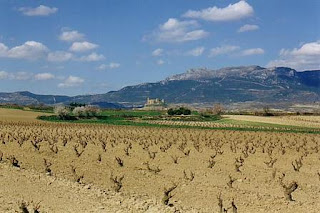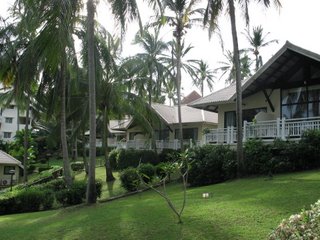Its name comes from the Spanish "temprano" which means early and refers to the fact that it ripens a few weeks earlier than most Spanish red wine grapes.
Until recently it was suspected that Tempranillo was related to Pinot Noir, but genetic studies tend to discount this possibility.
Tempranillo is the main grape used in the red wines of Rioja, Spain.

It has a thick skin and grows best at relatively high altitudes, but it also can tolerate a much warmer climate.
To get elegance and acidity out of Tempranillo, a cool climate is needed. But to get high sugar levels and the thick skins that give deep color you need heat.
The lower acidity associated with low-altitude growth is most often remedied by blending with higher acid grapes eg. Grenache or Granciano. Here in Australia we are allowed to add acid.
Pests and diseases are a serious problem for this grape variety, since it has little resistance to either.
The grape forms compact, cylindrical bunches of spherical, purplish black fruit with a colourless pulp. The fruit is very dark in colour and forms a bead-like sphere.

The wines can be consumed young, but the most expensive ones are aged for several years in oak. The wines are ruby red in colour, with aromas and flavors of berries, plum, tobacco, vanilla, leather and herb.
A few years ago I had the thought that maybe this variety would be good to grow in Australia and went to Rioja for a few weeks on a "study tour".
The Rioja region is very beautiful and the three main grape growing areas are very geographically distinct, the mountainous Rioja Alta, the rolling hills of Rioja Alavesa and the flatter river valley of Rioja Baja.

These three regions produce three different styles of Tempranillo because of the climatic and soil differences.
Red wines are classified into four catagories depending on age and length of oak storage. From the young "Rioja" through "crianza", "Rioja Reserva" and the wonderful "Rioja Grand Reserva".
The region also makes white wine (Viura, Malvasia) and crisp fruity rose' (rosados). It was the latter that took my fancy during the tour. We never see them in Australia as they are always drunk very young and virtually straight out of a barrel. I don't think many see a bottle.
Nothing quite like sitting in the shade of huge trees on a ancient square in some old Riojan village with a plate of slow roasted lamb and a jug of cold Tempranillo rose' on a blistering hot day.

The vineyards were quite unique. Instead of the usual trellised rows I was used to, the majority were grown as bush vines in some of the most inhospitable soil I had ever seen.
The winegrowers of the region were somewhat bemused at a lone Australian poking around and asking lots of questions. My lack of Spanish and in general their lack of English proved a bit of a hurdle but most went out of their way to help. I remember one bizarre conversation in my English accented German and a vigneron's Spanish version.

The wine centre of Rioja is the town of Haro with its extensive and informative wine museum. Here you can visit numerous wineries (Bodegas) and taste a huge variety of local wines at cafes', restaurants and wine shops.
So the upshot of all this was that eventually I planted some vines.
They turned out to be a bit fickle. Despite growing like weeds with huge canopies, they have not so far been great with yields. Maybe it's the clone, D8V12, but in Australia we dont have much choice. It's either that or nothing!
Some experts suggest they have to be a few years old before they start producing to their full capacity.
The first year I blended the small quantity off into a Pinot Noir rose'.
This year with another small quantity harvested I have decided to make a varietal rose'.
It was brought in at around 12.5 Baume and the expected high pH 3.8.
Fermentation on the skins lasted only for 6 hours before I decided enough colour had been extracted when the juice was drained off and fermentation finished. It has been racked off the lees and is now settling. When clarified we will adjust the acidity and bottle.
Will let you know the results in due course.




















No comments:
Post a Comment